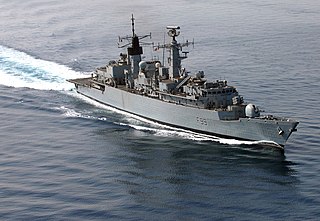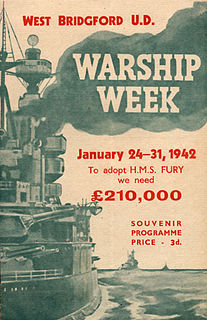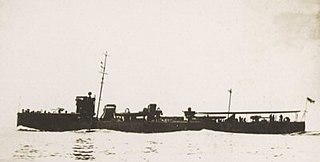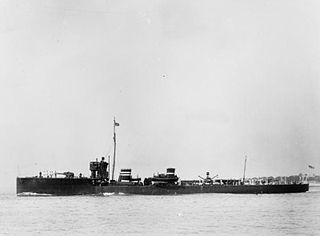
A cruiser is a type of warship. Modern cruisers are generally the largest ships in a fleet after aircraft carriers and amphibious assault ships, and can usually perform several roles.

The Type 22 Broadsword class was a class of frigate built for the British Royal Navy. Fourteen of the class were built in total, with production divided into three batches. HMS Cornwall was the last Royal Navy Type 22 frigate, retired from service on 30 June 2011.

The Brazen class formed part of a general class of forty turtleback destroyers capable of 30 knots built around the end of the 19th and the start of the 20th century for the Royal Navy.

HMS Badger was an Acheron-class destroyer of the Royal Navy that served during the First World War and was sold for breaking in 1921. She was the eighth Royal Navy ship to be named Badger, after the mammal of the same name.

The Acasta class was a class of twenty destroyers built for the Royal Navy under the Naval Programme of 1911 - 1912 that saw service during World War I. They were the last class of Royal Navy destroyers to have mixed names with no systematic theme When the class was designated as "K", names beginning with that letter were allocated to the ships but never used. The class saw extensive wartime service and seven were lost, including four at the Battle of Jutland.

HMS Ardent was an Acasta-class destroyer, the seventh Royal Navy ship to bear the name. She was launched in 1913, and was sunk at the Battle of Jutland in 1916.

HMS Delight was a Daring-class destroyer of the British Royal Navy, launched in 1950 as the Royal Navy's first all-welded warship, and broken up at Inverkeithing in 1971.

HMS Diamond was a Daring-class destroyer of the British Royal Navy. She was built by John Brown & Company in Clydebank, Scotland, and launched on 14 June 1950. This ship was John Brown & Company's first all-welded ship.

The Banshee class was a class of three torpedo boat destroyers that served with the Royal Navy into the early part of the Twentieth century.
The Violet class destroyer was a class of two destroyers that served in the British Royal Navy.

HMS Oak was a modified Acheron-class destroyer of the Royal Navy. Launched in 1912, she saw extensive service during World War I as a tender to the flagship of the Grand Fleet, and for this purpose she was painted white, instead of the usual warship grey. She was sold in 1921 to be scrapped. Named after the Oak tree, she was only the second ship of the Royal Navy to carry the name, and the first for over 250 years.

HMS Archer was an Acheron-class destroyer built in 1911, which served during the First World War and was sold in 1921. She was the fourth ship of the name to serve in the Royal Navy.

HMS Druid was an Acheron-class destroyer of the Royal Navy that served during World War I and was sold for breaking in 1921. She was the sixth Royal Navy ship to be named Druid, after the Druids of Celtic polytheism.

Warship Weeks were British National savings campaigns during the Second World War, with the aim of a Royal Navy warship being adopted by a civil community. During the early parts of the war, the Royal Navy not only had lost many capital ships but was facing increasing pressure to provide escorts for convoys in the Atlantic. While there was not a shortage of sailors, ships sunk by enemy action had to be replaced.

HMS Hind was an Acheron-class destroyer of the Royal Navy that served during World War I and was sold for breaking in 1921. She was the seventeenth Royal Navy ship to be named after the female deer.

HMS Forester was an Acheron-class destroyer of the Royal Navy that served during World War I and was sold for breaking in 1921. She was the ninth Royal Navy ship to be named after the traditional craft of forester.

HMS Lapwing was an Acheron-class destroyer of the Royal Navy that served during World War I and was sold for breaking in 1921. She was the seventh Royal Navy ship to be named after Vanellus vanellus, the northern lapwing.

HMS Sandfly was an Acheron-class destroyer of the Royal Navy that served during World War I and was sold for breaking in 1921. She was the seventh Royal Navy ship to be named after the small biting fly of the same name.


















